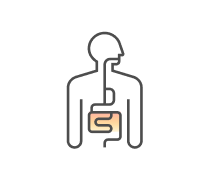Aerobic respiration produces ____________ ATP than anaerobic.
_________
...
___________ hydrolyzes
maltose into glucose.
______________ is
...
_________ respiration uses oxygen.
The wave-like movement of the muscles that control the movement of...
This is a bolus of food mixed with the secretions of the
...
Young people have a ____________ BMR than older people.
What gives bile its yellow-green color?
Digestion
...
Acidic chyme in the duodenum increases __________ secretion.
This is made up of undigested
...
____________ are
...
Females have a _________ BMR than males.
Where
...
________
...
____________ reactions
are decomposition reactions
_____ salts ________ fats.
____________
...
It is possible to overdose on ______-soluble vitamins.
Which vitamins are fat soluble?
The intramural plexus is made up of the ___________ plexus in the...
What is responsible for the intrinsic regulation of digestion?
During the ____________ phase,
...
The thoracic duct is part of the ______________ system.
This prevents digestion, by
...
______________
...
Chief
cells secrete _____________.
The _________ ___________ controls the exit of food from the _________...
The pH of saliva is around __.
_____
...
This is a double layer of serous membranes the hold
...
___________ i
...
__________ _________ is the
...
The ________ causes pancreatic secretions during the cephalic and...
The pH of an empty stomach would be __________ than the pH of a full...
Low pH increases gastrin release.
The central veins of liver lobules unite to form the _______ _____.
A blood vessel which
...
As
...
The presence of food in the
...
Both bile and pancreatic juice have a(n) __________ pH.
When oxygen is not present
...
What are the two sub-phases of the intestinal phase of...
A blood vessel which drains venous blood into the liver from the...
Proteins yield ___ calories of energy per gram, fats yield __ calories...
What are the two phases of gastric secretion? __________ and...
________ __________ __________ are building
...
_______ is a plant-derived, water ___________
...
____________ is the most important molecule in steroid...
_______
...
Portal area - situated at the corner of each _____, it is a complex
...
The ___________ system helps absorb lipids via the ______________.
_______
cells secrete ____ and _______factor.
Salivary ________ is inactivated at this low pH, so ___________...
The major function(s) of the large intestine are to:
The pH of the stomach is 2-6.
List the four tunics from the lumen side out.___________,...
_______production
...
A pH below __ inhibits gastrin release.
_____________ produced by cells of the duodenum.It’s
...
These are
...
Chylomicrons are water soluble and are absorbed through _______.
During this process, fatty acids are broken down 2 carbons at a
...
The release of which hormone causes the parietal cells to release more...
The intramural plexus is located within the _____ of the __________...
The _______ _____________ is a spinal cord ___________ nervous system...
Formed by the union of the
...
The
...
When _________ receptors are distended, there is a(n) ____________ in...
The parasympathetic nervous system terminates in the __________...
Aerobic respiration produces __ ATP per molecule of glucose.
Acidic chyme in the ___________ increases CCK secretion.
Bile is _______ to help neutralize acidic _______ as it enters the...
The pH of the large intestine is
The inhibitory phase is also known as the __________ ____________.
This
...
Anaerobic respiration
produces __ ATP per molecule of glucose
Within the mucosal cells, the fatty acids and
...
A blood vessel in the
...
_______ ______ cells of the stomach secrete mucus.
____________cells secrete a variety of hormones.
The ________ _________ is responsible for peristalsis and secretion.
CCK
...
One of several short veins
...
Low pH _____________ gastrin secretion.
Through
...
______________ is in
...
CCK is responsible for contractions of the ___________________, and...
_______
...
Due to the absence of ___________ acid (which leads to incomplete...
The pH of the _______ is 5-7.
Food in the duodenum
...
The pH of the distal small intestine is about ___ to ___.
The ____________ nervous system innervates the ____________...
The stimulus for the defecation reflex is ____________ of the...
What causes cholecystokinin
& secretin to be secreted?
What are the function(s) or hepatocytes?
__________________
break down peptides into amino acids.
The pH of the ileum/jejunum is around _________.
The
...
The pH of the duodenum is around _____.

















